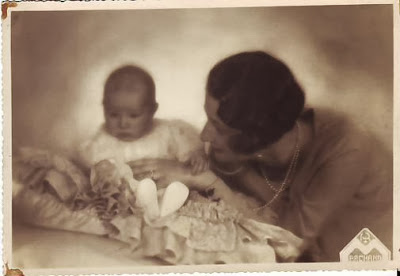Two pictures taken by the royal photographer Robert Marchand capture some moments of family tenderness. Above, we see Queen Astrid with one of her children. Below, Astrid's daughter, Josephine-Charlotte, and her half-brother Alexandre, play with their baby sister Marie-Christine.
Sunday, October 27, 2013
Saturday, October 26, 2013
The Princesses' Cookbook
Jenny Åkerström is credited as the originator of the recipe. Åkerström was a Swedish home economics guru at the beginning of the 20th century and was even an instructor to the three Swedish princesses, Margaretha, Märtha, and Astrid, daughters of Prince Carl (brother of King Gustaf V). She published a four volume series of cookbooks called Prinsessornas Kokbok: Husmanskost och Helgdagsmat (Princesses Cookbook: Home Cooking and Holiday Food). The first edition came out in 1929 with the princess’ portraits gracing the cover. With it’s great success came eighteen reprints with revisions up through 1952.
I wasn’t able to find any definitive information about why the books were called the princess cookbooks or why the princesses agreed to have their images on the cover other than the fact that Jenny Åkerström was their teacher and the princesses were seen as role models. Their education included child care and cooking which was innovative at the time. In a feminist sense, formal domestic training highlighted the professionalism required to manage a home and children.Korena Vine of Korena in the Kitchen gives more details on the origin of the name of the cake as well as beautiful pictures of it:
One story is that this later became known as “princess cake” (prinsesstårta) because the three princesses are said to have loved it so much. Another story is that Ms. Åkerström actually created three very elaborate “princess cake” recipes – a different one for each princess – and that the current version is a simplified combination of all three. That explains the princess connection, but the reason for the cake being green still seems to be a mystery. Today, prinsesstårta is popular in Finland as well as Sweden – so much so that the third week in September is officially Prinsesstårta Week!
Friday, October 25, 2013
What Do You Think of This?
This book is two years old, but I only heard of it today. La reine Astrid n'est pas morte à Küssnacht ("Queen Astrid Did Not Die At Küssnacht") is a novel of alternate history authored by Belgian aristocrat and politician, Stéphane de Lobkowicz. As the title indicates, the point of departure is that the iconic fourth Queen of the Belgians survives the fatal car accident on August 29, 1935. Rather than losing her life, she loses her husband, King Leopold III. Playing on the rumor that Astrid was pregnant at the time of the crash, the author even imagines that she bears Leopold a posthumous fourth child. Otherwise, Astrid disappears into the background of the story.
The foreground is taken by her mother-in-law, cultured, energetic Queen Elisabeth, who becomes Regent for the little heir to the throne, Prince Baudouin. It falls to the German-born Elisabeth to face off against Hitler. The Belgian campaign lasts for 22 days instead of the historical 18. The beautiful city of Bruges is burned to the ground. Elisabeth barely escapes with her life to England and continues the struggle from abroad, while a defiant Belgium is placed under the ruthless rule of Reinhard Heydrich, engineer of the Holocaust. (In reality, Belgium benefited from having Alexander von Falkenhausen, a military governor who made efforts to moderate the treatment of the population). In the post-war period, Belgium is spared the Royal Question, which erupts in the Netherlands instead! Queen Wilhelmina is blamed for her departure to London, rather than King Leopold being traduced for remaining in Belgium during the occupation.
Lobkowicz also manages to weave in characters such as Leopold's brother, Prince Charles, who actually served as Regent of Belgium from 1944-1950, Leopold's second wife, Lilian Baels, and Baudouin's Queen Fabiola. Charles is given a romantic interlude with a Congolese woman of mixed racial ancestry, whom he later marries. Lilian never marries Leopold, of course, but becomes his children's governess. In reality, she never served in this role, despite persistent myths and rumors to the contrary. While a refugee in Spain, sheltered with Fabiola's family, Baudouin meets his future bride, two years his senior.
While I am not particularly attracted to reading this book, and something about the whole tone of the story even strikes me as unpleasant, La reine Astrid n'est pas morte à Kussnacht is certainly inventive. It is always interesting to consider alternate historical scenarios, so please feel free to suggest any others in the comments.
Friday, October 18, 2013
Blessing a King and Queen
I cannot post the picture here, but please follow the link to see this stained-glass window from St. Rumbold's Cathedral in Mechelen. The seventh-century St. Rumbold is shown blessing the twentieth-century King and Queen of the Belgians, Leopold III and Astrid.
A Royal Thank-You
Here is a card from King Albert II and Queen Paola, expressing their gratitude for the greetings and good wishes sent to them by their subjects and by other friends of the Belgian Royal Family, on the occasion of the royal couple's Golden Wedding in 2009. The upper text in Dutch is by Paola, the lower text in French by Albert. The note reads: "Heartfelt thanks for the good wishes, which deeply touched us."
Subscribe to:
Comments (Atom)





